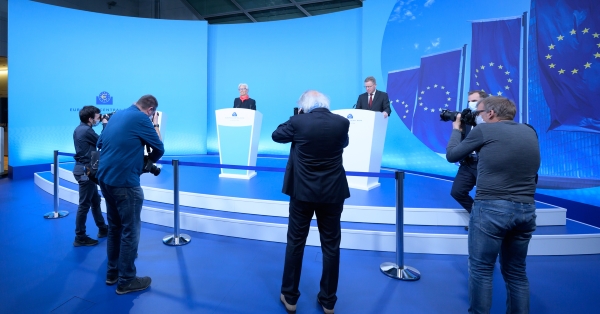2022 set for bumper, bumpy reopening as inflation, Covid complicate macro outlook
Following last week’s ECB and Fed decisions, and with Covid-19 and inflation uncertainty only increasing into the new year, financial issuers will have to navigate an even busier January primary market than expected amid heightened risks. Neil Day reports, with insights from Crédit Agricole CIB analysts and syndicate in London, New York and Paris.

You can also download a pdf of this article here.
The European Central Bank and Federal Reserve set the stage for the new year primary market last week, with hawkish-leaning decisions that cemented expectations of rates volatility in 2022 and ratcheted up supply expectations.
A taste of what was to come was provided on the morning of the ECB meeting on Thursday, when take-up of €50bn in the last TLTRO III was revealed. Combined with €60bn of repayments, this resulted in a net take-up of minus €10bn — the first reduction in TLTROs since September 2019.
The ECB then came out on the hawkish side of expectations in not announcing any new TLTROs, but, rather, confirming “it expects the special conditions applicable under TLTRO III to end in June next year”.
“TLTRO modalities could still be changed,” said Crédit Agricole CIB (CACIB) ECB strategist Louis Harreau, “but the ECB wanted to give the clear message that they will not. This means that one could expect significant repayments of TLTRO II in June 2022 — and we mean a very big repayment amount.”
The lack of TLTRO news came on top of the ECB confirming the March end of the Pandemic Emergency Purchase Programme (PEPP). Although the Asset Purchase Programme (APP) is being boosted across the second and third quarters to, in effect, taper the exit from PEPP, and the ECB stressed its flexibility in respect of QE going forward, confirmation of PEPP’s March end underlined the central bank’s concerns around inflation as it revised its projections upwards.
The ECB meeting came the day after the Federal Reserve on Wednesday doubled the speed of its taper and confirmed a more aggressive tightening path, with three rate hikes now expected in 2022, setting the stage for the new year and allowing the pandemic to enter the spotlight once more.
“Everyone has been waiting for weeks to have these two meetings behind us,” said Vincent Hoarau, head of FI syndicate at CACIB. “They were more hawkish than expected, but that was to a certain extent priced in, because as soon as you look at inflation numbers, you cannot expect anything different, and the first reaction was rather positive.
“But the market has since started to realise that things are not getting better on the medical front.”
A renewed lockdown in the Netherlands has been followed by tighter restrictions in many European countries, leaving the outlook finely balanced.
“If Omicron fears are overdone, then there will be volatility as accommodative policies come to an end, but the market has faith in the Fed and the ECB in this scenario and the market will hold. However, if everywhere locked down again in January, there is the risk that the market dislocates.
“While we are looking at a situation in many ways similar to a year ago, there is the key difference that inflation is 5% higher, so central banks’ room for manoeuvre is very limited and they face the dilemma: combat inflation or defend the recovery? This is the worst case scenario for everyone.”
Approaching the Christmas weekend, Omicron statistics were equivocal, with a surge in infections yet to translate into the level of hospitalisations and deaths that had been considered a possible consequence of the new variant, and vaccines and boosters potentially standing populations in better stead than in previous waves.
Either way, the combination of the ECB’s hawkish inclination and the arrival of Omicron look set to make the January primary market even more challenging than it was already expected to be. While the traditional New Year wave of supply will meet the prevailing and new pools of liquidity, the latest developments could tilt the supply/demand balance away from issuers.
“On the one hand, you could have some investors staying on the sidelines saying, the environment is too unsettled, I’d rather wait and see,” said Hoarau (pictured), “while the rates volatility means their inclination to put money to work at the long end will be more limited. On the other hand, you will have issuers keen to print because funding programmes are by definition heavier in 2022 than they were in 2021, and when you are a big issuer dealing with only a handful of issuance windows across the year, you cannot afford not to do at least 25%-30% of your issuance in January. This means January will be heavy across the board — across the capital structure, across jurisdictions.

“Particularly given that credit spreads are close to historic lows, it is hard to see how spreads will be tighter at the end of January than the beginning of January, so there will be a strong advantage for first movers ready to tap into the abundant liquidity available at the start of the year. The vast majority of investors will feel forced to invest.”
The first issuance window in Europe is likely to be short, with London closed on Monday, 3 January, and parts of continental Europe enjoying public holidays on Thursday, 6 January.
“There is a strong need to be vigilant and pragmatic when it comes to pricing approach in January,” added Hoarau, “particularly in unsecured, sub new issues.”
Meanwhile, the covered bond market is expected to be one of the biggest beneficiaries of the ECB’s reining in of TLTROs, with CACIB forecasting some €25bn of euro benchmark supply in January.
“We believe covered bonds will continue to enjoy their strong safe haven status,” said Hoarau, “and serve issuers as a strong funding tool in conventional as well as ESG format.”
Fed primes dollar market
The dollar market is expected to enjoy a smoother start to the year, given greater confidence in the Federal Reserve’s ability to combat inflation without jeopardising economic growth.
“The December FOMC meeting saw a taper announcement in line with expectations combined with a couple of modest surprises elsewhere to confirm the abrupt hawkish shift that had been evident in Fed communications in the lead-up to the meeting,” said CACIB US economist Nicholas Van Ness.
Indeed, Daniel Kim, director, US syndicate, at CACIB, notes that Fed fund futures had already priced in the rate hikes and that the market reacted calmly.
“US investors welcomed the news that the Fed is quickly acknowledging inflationary stress points and adjusting monetary policy accordingly,” he said. “It is clear that Powell is comfortable with the economy handling the newest viral threat (Omicron), understands that the labour market is stronger than the previous expansion, and that higher inflation may be the chief threat to maximum employment.
“Based on the FOMC’s decision, economic analysis and market reaction, we believe the fundamental backdrop for the primary market is positive and prime for an active January,” added Kim. “We trust issuers will be well organized to arrange their funding needs for an early January start.
With the US having a full working week at the start of the year — albeit with non-farm payrolls due on the first Friday — issuance is expected to kick off as early as Monday, 3 January. Yankee issuance is likely to be first on the agenda, according to Kim, with financial institutions looking to opportunistically issue higher beta structures, such as AT1 and Tier 2, and incorporate green alongside conventional tranches.
After reporting earnings from 14 January onward, US banks are expected to enter the market following the long weekend finishing on Monday, 17 January (Martin Luther King Day). Consensus estimates point to some $130bn-$135bn of supply in investment grade credit across January, slightly down on January 2021’s $137bn.
